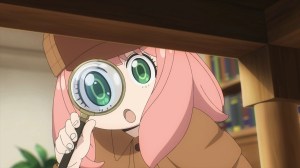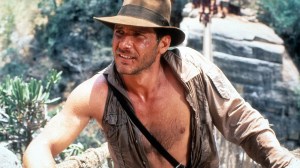
No, this is not an announcement of a new crossover mini-series.Sorry.Though there have been Superman/Aliens crossovers. If you squint just right, The Kingpin might as well be Lex Luthor, right?
Videos by ComicBook.com
Aliens in the 50s
“Aliens: Earth Angel” is a one-shot that Dark Horse published in 1994. It’s an original Aliens story written and drawn by John Byrne that Previews originally serialized first.
Yes, everyone’s favorite magalog once carried serialized stories, usually in two page increments. In addition to this one, I know Frank Miller did a Sin City short like that, and I think Mike Mignola did a “Hellboy” story, too, but don’t quote me on that.
If you read this story carefully, you’ll see how the structure worked, and how every two page segment seems to have a exclamation point or shocking twist in the story. If you didn’t know about that, though, you’d think it was just one of those roller coaster rides that keeps having dips in a regular rhythm.
It’s a fun structure to the story.
It is also a “Greatest Hits” edition of the “Aliens” franchise. I’ve only seen the first two movies, but that’s all I needed to know to get this. You get everything you’d want to see Byrne do in this book, from the Xenomorph, himself, to the face huggers, the chest bursters, alien eggs, the smaller alien head coming out of the mouth of the bigger alien, and the deaths by fire.
Byrne mixes it all together in a good way. He recasts it by setting this story on earth in the 1950s. It’s a small town where an alien ship crash lands, unleashing a Xenomorph monster on the town.
The good country doctor gets a good look at it first and starts to run. Meanwhile, the biker gang hoodlums, looking like the background cast members of a shady production of “Grease,” are hanging out at their biker bar across town and causing the usual kinds of trouble they might.
One of them meets an alien outside, and all heck breaks loose.
It’s a short story, entirely told in 24 pages, with a last panel twist that helps to cement it in the canon of the Aliens continuity.

Byrne’s art is terrific, particularly in the parts where he’s playing with explosions and burning aliens and extreme differences in light, like when the biker is shining his light in the dark forest. I just like the way it all looks.
He also gets credit for naming the bartender in the comic “Augie.” He might get demerits for naming one of the biker’s girlfriend “Angie,” though. Too close!
The packaging from Dark Horse is very nice, too. Besides the cardboard cover with wraparound art and the uninterrupted story, the paper used is a good solid stock. Published in 1994, newsprint and lesser paper stocks were still popular. This was not glossy shiny paper that makes it impossible to read under the wrong light. Matt Webb’s coloring — which is bright and filled with lots of colors — jumps off the page without distracting from the art.
“Aliens: Earth Angel” is a fun pulpy/poppy bit of storytelling from John Byrne that’s worth a read if you ever come across it. Good news — it’s available on Comixology for a dollar now.
A Classic But Gut Wrenching Spider-Man One Shot

Critically lauded at the time, 2004’s “Tangled Web” #4, titled “Severance Package”, deserved every word of praise it got. It still does. If you haven’t read it in awhile, go back and do so now. It might be even better than you remembered.
It’s a master class from Greg Rucka and Eduardo Risso on how to deliver a comic book story in 22 pages.
Rucka’s opening scene grabs you by the collar and then pulls you through the rest of the book. There’s not a single slow moment in the issue. It’s a real page turner. The story is that one of the Kingpin’s operations is disrupted by Spider-Man. (He only appears in silhouette in one panel for the entire issue.) The man responsible for the operation, Tom Cochrane, sees it on the news and knows he’s a dead man because of it.
That’s when the phone rings inviting him to come see Kingpin immediately. He calmly readies himself for the meeting which he knows will be the end of him, while his wife begs him to find another way. He knows better, though. He’s eerily calm in the face of his certainty, asking for a cup of hot coffee and his favorite suit.
It’s a heart breaking story that doesn’t let up for the entirety of it the issue. Every page is tense. You’re watching an inevitable tragedy, but your mind races at all the possibilities for how it might end differently. Rucka doesn’t ignore them, either. The wife in the story plays the voice of the reader, but he knows better. He knows too much.
With a couple of twists at the end, the story ends in a satisfying manner, but you’re left reminding yourself to breathe again. The story is over, and it’s just that good. Then you can go back and read it again to pick out all the subtler parts of the storytelling and see how well each element in it is set up, fleshed out, and capitalized on.
As good as Rucka is in delivering such a personal crime story like this, Eduardo Risso’s art shines. When Cochrane enters the Kingpin’s offices, it’s epic. Just a panel of a man walking out of an elevator and into the Kingpin’s office will take your breath away.

The previous page showing Tom ascending in the elevator is a great bit of panel work — a series of squares that get bigger and bigger as the elevator climbs up closer to the reader’s point of view.

There are many silent panels throughout the issue. Risso draws all the right details and hits all the right beats for this story. This book almost feels like a mystery. You find yourself absorbing all the details to try to keep one step ahead of where things are going. Usually, you’re overthinking, but it’s fun to get so lost in a story like this.
It’s ultimately very satisfying and complete, which is a rarity in single issue comics today. (That might also be part of the reason I gravitate to so many European comics recently, too.)
Thankfully, this issue is available digitally for the paltry sum of two bucks. It’s worth it; trust me.
Check out the rest of the “Tangled Web” series while you’re there, for work by Keith Giffen, Duncan Fegredo, Darwyn Cooke, Jim Mahfood, Paul Pope, and lots more.
PipelineComics.com|| Twitter || Instagram || E-mail




![TMNT: The Last Ronin II Reveals the Return of [SPOILER], Sets Up Finale Showdown](https://comicbook.com/wp-content/uploads/sites/4/2025/01/TMNT-The-Last-Ronin-2-4-Kevin-Eastman.jpg?w=300)
